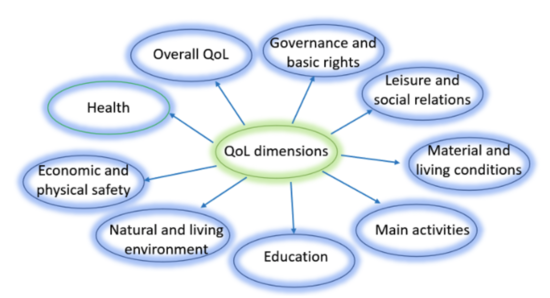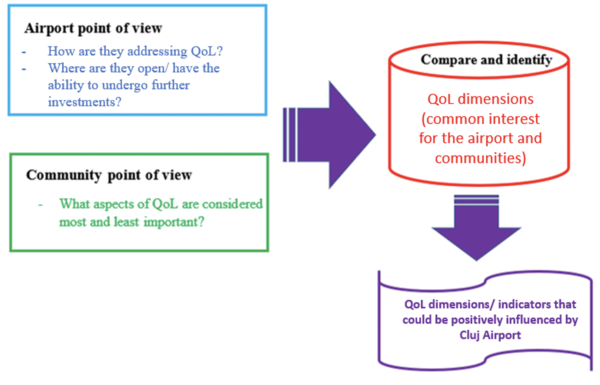Drawing upon existing knowledge from ANIMA regarding QoL around airports, a set of QoL dimensions and indicators was developed and tailored according to the local airport context. Furthermore, different types of questions were developed in parallel (for the airport and for residents) for each selected indicator, together with possible answering options.

Figure 1. QoL dimensions used within the design of the airport interview and population survey
Nine QoL dimensions were selected, including health, economic and physical safety, natural and living environment, followed by corresponding indicators such as annoyance, impact on water/ soil quality, emissions etc. As a result, a questionnaire for the airport was developed, having a final version containing 29 questions. Similarly, the second questionnaire for residents included 47 questions. For assessing the individual QoL perspectives, the study was focused on understanding the airport’s point of view and the perspective of residents from communities close to the airport. In this respect, the airport feedback was collected through an interview approach and the responses of residents through a survey.

Figure 2. Quality-of-life study outline
The perspective of residents was important for understanding the priority of QoL elements, while the perspective of the airport was relevant for identifying which past/ present actions influence QoL and what could be the future opportunities to support an increase in the wellbeing of residents, through their future strategic planned activities. Consequently, the comparison of the two points of view has resulted in identifying if QoL elements that the airport was focused on were also the priorities of residents. The study outline is depicted in the above figure.
Both the interview and the survey were conducted online, through the use of various communication tools. The interview and the survey were formulated in English and translated into the local language (Romanian). Therefore, feedback was collected in Romanian and translated back into English for data analysis. A total of 256 responses of residents were collected. Some were excluded from the analysis, based on different criteria of non-compliance with the study (e.g. from people living/ working in cities that are located at distances over 30 km from the airport). Both quantitative and qualitative analyses were performed.